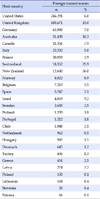Abstract
Purpose
The purpose of this study was to identify the current issues concerning a mutual recognition agreement (MRA) for nursing professionals, and to suggest policy alternatives in South Korea.
Results
The nursing MRA was signed by the European Union, the Association of Southeast Asian Nations, Australia-New Zealand, India-Singapore, and the Caribbean Community. The United States and Japan have not concluded a nursing MRA with other countries, but they have lowered the entry barriers for foreign nurses from certain countries. In order to prepare for a nursing MRA with developed countries such as the United States, Canada and Australia, it is necessary to establish international standards for nursing and to build a verification system for the qualifications of foreign nurses. In addition, there is a need to establish an independent professional licensing authority that assumes responsibility for all the tasks regarding a nursing license.
Figures and Tables
References
1. Kim JG. Policy direction for mutual recognition of medical professionals: Comparing licensure system of Korea and the United States. ResearchData (Korea Institute for International Economic Policy), vol 06-01. Seoul: Korea Institute for International Economic Policy;2006.
2. Kang CH, Yun SN. International migration of Korean nurses. Journal of Korean Community Nursing. 2005; 16(1):86–94.
3. Klin DS. Push and pull factors in international nurse migration. Journal of nursing scholarship : an official publication of Sigma Theta Tau International Honor Society of Nursing / Sigma Theta Tau. 2003; 35(2):107–111. DOI: 10.1111/j.1547-5069.2003.00107.x.
4. Korean Nurses Association. History of nurses overseas employment. Korean Nurse. 2004; 43(4):14–17.
5. Organization for Economic Cooperation and Development. Health workforce migration [Internet]. France: Organization for Economic Cooperation and Development;2018. cited 2019, February 5. Available from: https://stats.oecd.org/Index.aspx?DataSetCode=HEALTH_WFMI.
6. International Council of Nurses. Career moves and migration: Critical questions guidelines. Geneva: International Council of Nurses;2010.
7. Kingma M. Nurses on the move: a global overview. Health Services Research. 2007; 42(3 Pt 2):1281–1298. DOI: 10.1111/j.1475-6773.2007.00711.x.



8. Kim JG. Status of mutual recognition of professional qualifications and future tasks. KIEP World Economy. 2006; 9(8):94–108.
9. Chung KS. The 23rd ICN Congress-World healthcare trends. The Korean Nurses Association News. 2005. 06. 02. Sect. Issues/Planning Available from: http://www.nursenews.co.kr/main/ArticleDetailView.asp?sSection=61&idx=6092.
10. Wang SH. WTO DDA and healthcare services negotiation. Korean Association of Internal Medicine. 2002; 63(2):355–362.
11. Yu G, Lee J, Lee K, Kyung S, Hong J. Strategy of ‘WTO Doha development agenda negotiation’ mode 4(manpower mobility). Seoul: Korea Institute for International Economic Policy;2004.
12. Song JH. Free trade agreement and international migration of health-care workers: The case of Japan. International Trade Law. 2013; (110):129–166.
13. Committee on the Robert Wood Johnson Foundation Initiative on the Future of Nursing, at the Institute of Medicine. Robert Wood Johnson Foundation. Institute of Medicine (US). The future of nursing: leading change, advancing health. Washington, D.C.: National Academies Press;2011.
14. European Commission. Automatic recognition. Recognition of professional qualifications in practice. Free movement of professionals [Internet]. European Commission;cited 2019, January 20. Available from: https://ec.europa.eu/growth/single-market/services/freemovement-professionals/qualifications-recognition/automatic_en.
15. Association of Southeast Asian Nations. ASEAN mutual recognition arrangement on nursing services [Internet]. updated 2012, July 6. cited 2019, January 20. Available from: https://asean.org/?static_post=asean-mutual-recognition-arrangement-on-nursing-services.
16. Aungsuroch Y, Gunawan J. Nurse preparation towards ASEAN economic community 2015. International Journal of Health Sciences and Research. 2015; 5(3):365–372.
17. Association of Southeast Asian Nations. AJCCN achievements (2007–2015) [Internet]. Bangkok: The ASEAN Joint Coordinating Committee on Nursing;2016. updated 2016, January 25. cited 2019, January 20. Available from: https://www.asean.org/storage/2012/05/Summary-of-AJCCN-Achievement-2007-2015-Regional-and-National.pdf.
18. Indian Nursing Council. Singapore Nursing Board. The comprehensive economic cooperation agreement between the Republic of India and the Republic of Singapore mutual recognition agreement on nursing services [Internet]. cited 2019, January 22. Available from: https://www.indiannursingcouncil.org/Pdf/Mutualrecognitionagreementonnursingservices.Pdf.
19. Reid UV. Regional examination for nurse registration, commonwealth Caribbean. International Nursing Review. 2000; 47(3):174–183. DOI: 10.1046/j.1466-7657.2000.00012.x.


20. Lee YD, Jung KS, Choi SB. A study on the establishment of license administration regulation with regard to the cross-border movement of medical personnel: From the perspective of mutual recognition agreement. Research Project Report, vol 2003-2-2. Seoul: Research Institute for Healthcare Policy;2003.
21. Gabriel C. NAFTA, skilled migration, and continental nursing market. Population, Space and Place. 2013; 19:389–403. DOI: 10.1002/psp.1780.
22. Kim JY. Acceptance system for foreign nurses and caregivers in Japan. Wonkwang Law Review. 2016; 32(4):93–118. DOI: 10.22397/wlri.2016.32.4.93.
23. Japan International Cooperation of Welfare Service. Pamphlet on the acceptance of foreign nurse and caregivers under EPA 2019 [Internet]. cited 2019, January 15. Available from: https://jicwels.or.jp/?page_id=16.
24. Ministry of Health, Labour and Welfare (Japan). Acceptance of foreign nurse and caregiver candidates based on economic partnership agreement [Internet]. Tokyo: Ministry of Health, Labour and Welfare;2018. cited 2019, January 15. Available from: https://www.mhlw.go.jp/content/000450797.pdf.
25. Akaba K, Takao K, Sato K. Problems over the supporting attitude to foreign candidates for EPA care workers: Using as a clue the relationship between the supporting attitude to the institutes and candidates' working and training conditions. Shakaigaku Ronso. 2012; 174:1–19.
26. Korea Health Personnel Licensing Examination Institute. Foreign nursing college recognized by the minister of health and welfare. Seoul: Korea Health Personnel Licensing Examination Institute;2019.
27. Jung YH, Ko SJ. A study on WTO/DDA negotiations and impacts in health services. International Area Studies Review. 2005; 9(2):108–139.
28. Shin EC. Mutual recognition policy of medical license for medical professionals under Free Trade Agreement. Journal of the Korean Medical Association. 2012; 55(4):316–318. DOI: 10.5124/jkma.2012.55.4.316.

29. Asakura K, Asakura T, Hyodo C, Ohara-Hirano Y. Issues of receiving foreign nurses to Japan by the schema of the Japan-Philippine Economic Partnership Agreement. Bulletin of School of Health Science, Tohoku University. 2009; 18(2):67–74.
30. Lee T, Kang KH, Ko YK, Cho SH, Kim EY. Issues and challenges of nurse workforce policy: a critical review and implication. Journal of Korean Academy of Nursing Administration. 2014; 20(1):106–116. DOI: 10.11111/jkana.2014.20.1.106.





 PDF
PDF ePub
ePub Citation
Citation Print
Print







 XML Download
XML Download